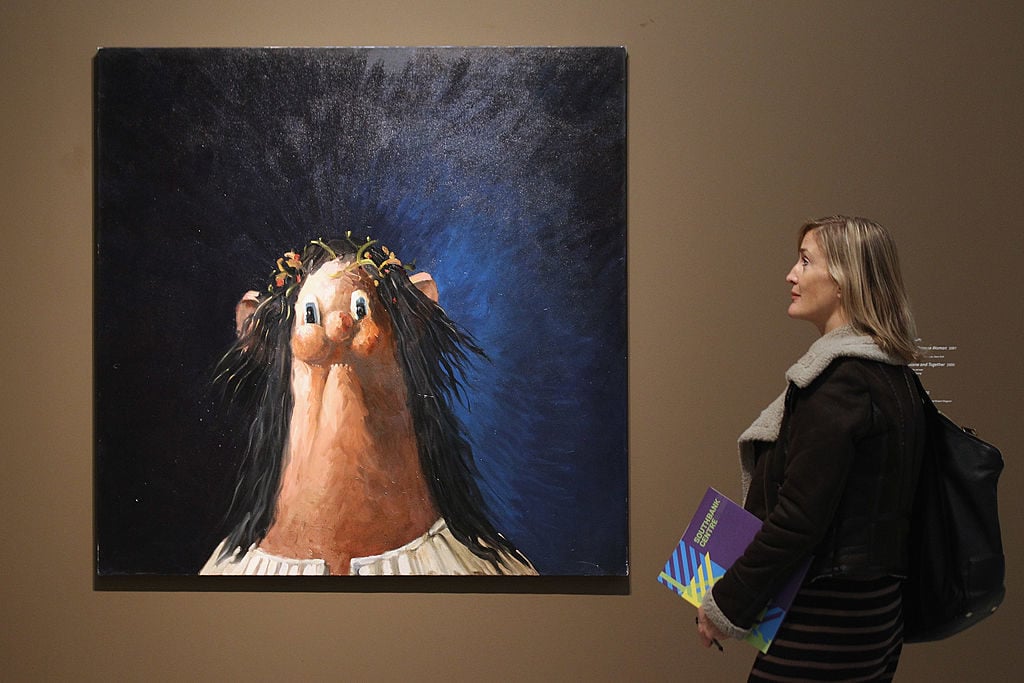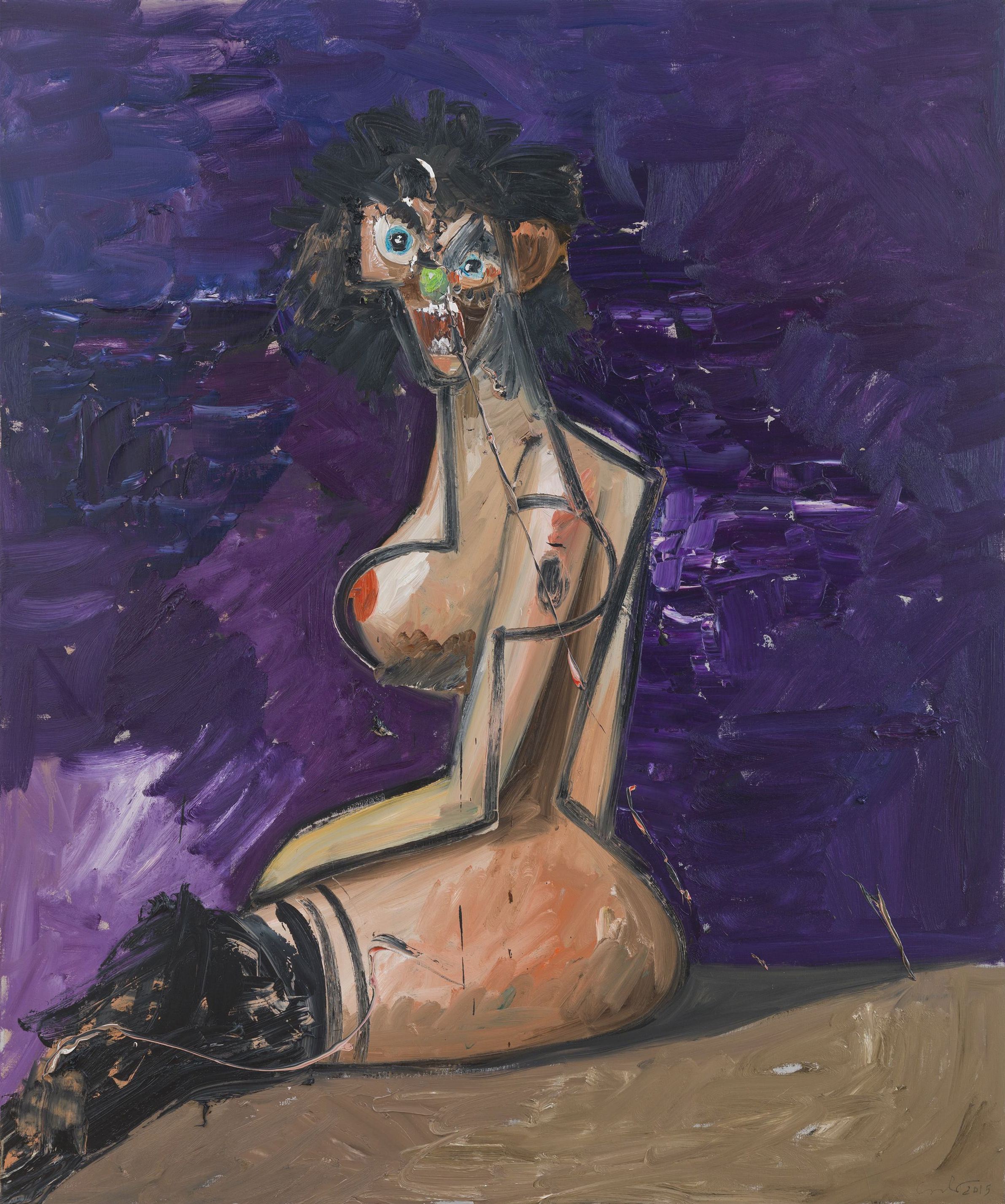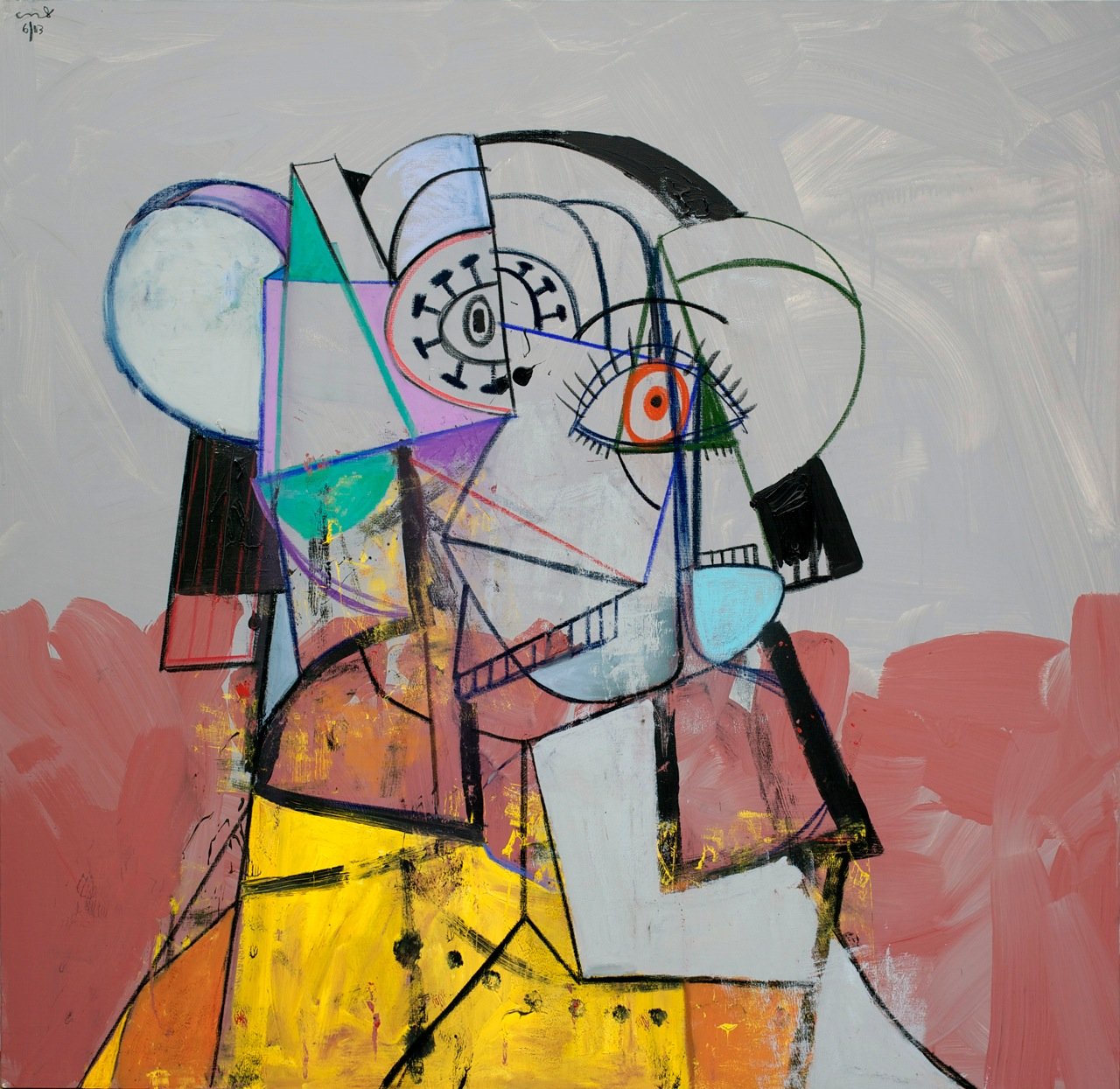Art & Exhibitions
artnet Asks: George Condo Sees Faces and Screaming Heads Everywhere
The artist explains why painting is far from dead.

The artist explains why painting is far from dead.

Emily Nathan

American artist George Condo, recovering from a spate of medical incidents that include, most recently, vocal-chord surgery, has lost his voice—but that doesn’t stop him from talking. In Paris last week to install a major wall of his figurative compositions for the exhibition “Picasso Mania” at the Grand Palais, he invited artnet News to the gated garden of his 8th arrondissement hotel for an afternoon chat. “It’s totally weird,” he rasped, giggling silently, “but even though I can speak French perfectly, I can’t understand a thing.” It was here, after all, that he spent a number of years in the mid 1980s, working out of shoddy hotels in the Rue Castiglione and eventually luring pals Keith Haring and Jean-Michel Basquiat over from New York to join him.
In the decades since, the Manhattan-based Condo—who was born in New Hampshire—has pioneered an eclectic yet singular style that has drawn the attention of such celebrities as Jay-Z and Kanye West, and he is widely considered one of the preeminent painters of the late 20th century. His particular brand of vibrantly colored, dynamic figuration incorporates elements from Surrealism, Expressionism, Pop Art, Disney World, and graffiti, and cites artists that range from the Old Masters to Francis Bacon, while remaining undeniably and distinctly his own.
His inclusion in the Picasso show, which tracks the Modernist Master’s influence on generations of artists who came after him, also acts as an appropriate prelude to a renegade presentation that will debut at Berlin’s Berggruen Museum next November, placing Condo’s works in dialogue with historical pieces from the institution’s collection.
In the meantime, though, Condo is savoring his return to the City of Lights—where “you can do whatever you want, if you’re willing to pay the price.” Sipping hot tea and croaking like a champ, he explained what Picasso taught him about psychology and why he can’t get rid of the monsters in his paintings.

George Condo Purple Nude II
Photo: Courtesy of the artist and Skarstedt
“The only way to feel the difference between every other and me is to use other artists to become me,” you once said. What did you mean?
Well, I’m not sure which philosopher it was—Aristotle or Socrates I think—who said that a “thing” is everything that it’s not, and that’s the way to describe definitively what something is. So everything that I love or am interested in or am impressed by in art goes into my work. I can only distinguish myself by understanding that all of those things are in my paintings, and then my works still come out looking like something entirely new and different. It’s really about reconstructive as opposed to deconstructive art: bringing the inter-relationships of languages in art together in a single canvas. My intention when I go into a work is to make people aware of all the great things I think there still are to draw from in painting.
Your paintings often contain the recurring trope of a kind of monster, its screaming head contorted and deformed by hysteria. What was the genesis of this image?
You know, Phillip Guston and all those artists who are our heroes, they all got it from Picasso: That screaming head you see in Guernica kind of got consumed into their language of abstraction. And for me as a painter, I see all that when I look at abstract paintings. When I see a network of brushstrokes and a cosmos of imagery in a Jackson Pollock, for example, I see faces and screaming heads, and I want to paint what I see. So real life is involved with that. We see reality through our own eyes. Say I see two people talking on a bus, and I don’t know what they’re talking about but their faces are sort of thrown back in some hysterical expression—and I just want to capture that at the moment I see it, even though it might be out of context when it shows up in my work.
Are you saying that what we call reality is actually inherently artificial, especially since we can only experience it as filtered through our own perceptions?
Our own experiences of the world are really all we can go off of. If you look up the word “artificial” in Webster’s dictionary, the definition is “man made.” And the world we live in is “man made.” If you look up “reality,” though, the definition is something like “that which exists independent of our perception.” So according to this definition, if it’s out there beyond where we can perceive it, then it’s real. But what we generally describe as “concrete reality” is actually the artificial. Now, let’s just say you decide to become a very representational painter and to sit here and paint exactly what you see. So then you’ve created a very realistic representation of that which is artificial—what do you call it? It was Robert Rosenblum, actually, who said, “What do you call this stuff you do? It’s not Surrealism, it’s not Expressionism.” And I thought about it and I said, Robert, you can call it Artificial Realism.
Indeed, this idea of “Artificial Realism” seems counterintuitive at first.
Basically, Artificial Realism is the realistic representation of that which is artificial. And in order to get to that realistic representation, you need a kind of traditional background in painting. And that’s what’s genius about Picasso. We all know he mastered painting as a teenager, and that from there on it was a mission of deconstruction.
If you go back to his early sketchbooks, or the sketchbooks of Léger, Matisse, Duchamp, they’re all these technically masterful academic studies. And in our case, for the artists of my generation, our early sketchbooks look like Kandinsky abstractions—they look like abstract art. Because we all actually started as abstractionists and have worked to turn abstraction back into reality. Picasso and his contemporaries turned realism into abstraction by deconstructing it, but people from my generation went the other way; we went through conceptual art to get back to reality. And we can’t really see it through any other lens, we can only see it the way it was given to us by Lawrence Weiner and Jacob Kossuth, Donald Judd, and Ryman.
That work is the world that we grew up with. Our Guernica, as painters, was not Vietnam, let’s just say. It was, “What happened to painting? Where did it go?” So people like Baudrillard say painting is dead. I disagree. I once said that there is more life in the death of painting than people realize. And I wasn’t being a necrophiliac—I was saying that in that silent moment, when painting was underappreciated, there was actually a lot happening; there was a sort of a volcanic uprising about to take place.

George Condo Portrait with Grey Forms (2013)
Photo: Courtesy of the artist and Skarstedt
In light of your inclusion in the exhibition at the Grand Palais, can you talk about your relationship to Picasso and his work?
Picasso really ups your game as a painter. He sets the bar high. You gotta be really good at drawing hands, you gotta be good at drawing bodies, you gotta know how to be spontaneous—and you have to exhibit all of that in a very improvisational way. Picasso takes what’s neat and pretty and clean and he turns it into what it really is, like an ugly monster. Honestly, my paintings are full of these monsters and I’m seriously getting sick of them. Part of my process is like, these characters are in my head and I want them outta there, so I’m trying to kind of paint them out of my system. The thing is, if I tried to paint people the way I really see them, it’s not going to be the way they see themselves. So what good is that going to do? But when people see the monsters in my paintings, sometimes they are able to see a very distorted version of the way they see themselves—they can recognize something of themselves in it.
So in a way, you’re over-shooting—or exaggerating—reality, in order to get closer to reality? To give people something they can relate to?
Right, I’m exaggerating and personifying some of their extreme emotional vicissitudes. There is this idea in method acting, for example, where there is a real meltdown in the middle of the movie; that heightened moment when humans break down and show it all in front of the camera. And I love the freedom to capture that in painting, where it’s like, these are the limits of hysteria, these are the limits of humanity, this is how far people really take it, and how far I see them take it. And I guess that was the other thing I got from Picasso. It’s the idea of Cubism—but rather than seeing and depicting this coffee cup, say, from four different angles at the same time, I’m seeing a personality from multiple angles at once. Instead of space being my subject, I’m painting all of someone’s emotional potentialities at once, and that’s what I’d call Psychological Cubism.
Honestly, I think it’s kind of rude for painters to paint people in one state of mind. It’s limiting; it’s not human nature. It’s like cutting out a whole portion of that person’s reception of the world, how they receive and react to the world. I think reactions are very important.
The Picasso exhibition asserts that Picasso has been a liberating force for many artists who came after him—that he allowed artists to “allow” themselves.
Yes, that’s what it was. What I realized is that painting is about the interrelationship of languages in art, just as life in the world is about the interrelationship of languages in human existence. And you can bring very dissonant voices together in some kind of cathartic harmonic way, you can create a sort of harmony out of things that seem diametrically opposed. And I think Picasso was one of the pioneers of that, because he knew that to represent the struggle that goes on in the world today, you have to recognize and acknowledge it. To depict what people really look like and what they do behind closed doors—that’s truly what my work is about.
Picasso.Mania is on view at the Grand Palais in Paris from October 7 – February 29, 2016